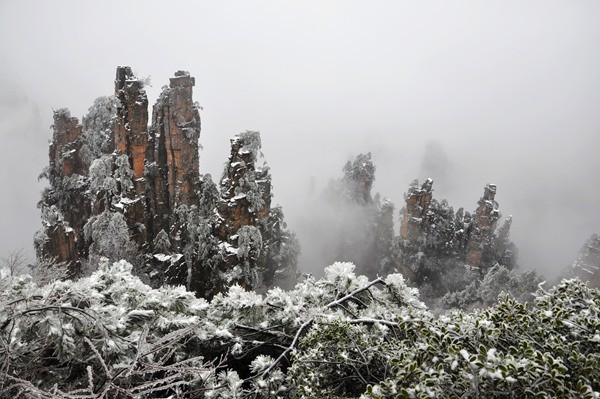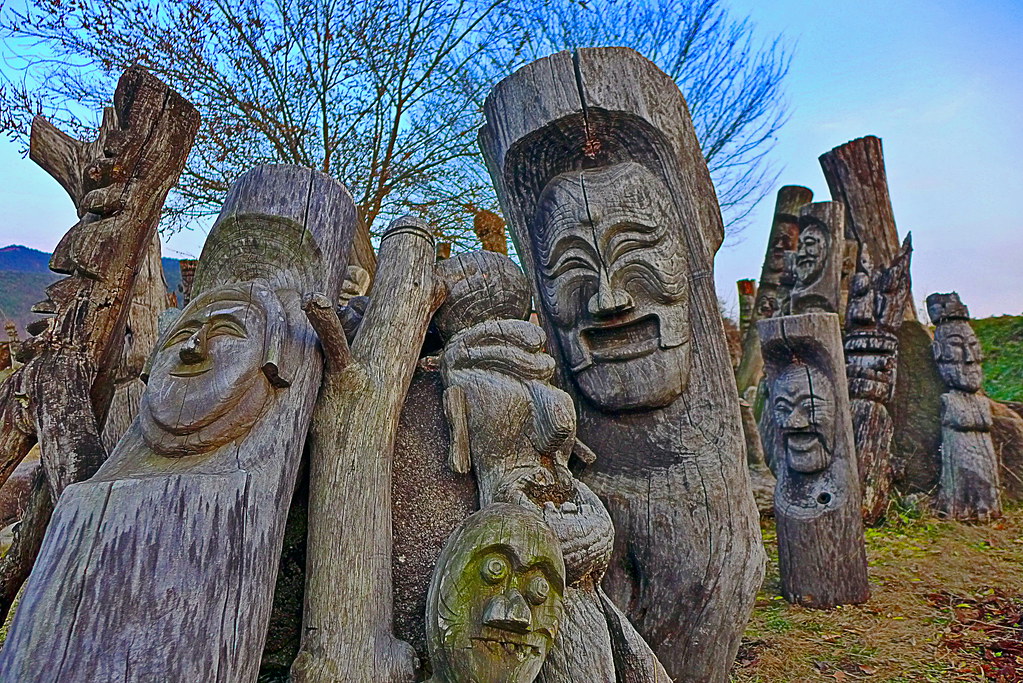Lower Druk Yul
Bulette - Wayward backwash of dragons, the bullete is a vicious ambush predatory who lurks in the yellow-dappled hills of lower Druk Yul. Each bullete exists in a state of perpetual rage. In life they live in endless hunger, seeking to feast upon man and beast who should be filial chattel to draconic masters, a position they will never hold. In dreams, they turn and churn in froth-mouthed loathing envy for wealth, status, and the ability to fly upon the moonlit skies. Few, save for the most bold of royalty, seek to make a bulette part of their menagerie. Most know well enough to avoid their path.
Ankheg - The Grasshopper men of lower Druk Yul are territorial and barbarous, and among the most violent of them are those who undergo the five-fold murderous right of the Ankheg. Baptized in the blood of larvae and of a herd caterpillar, the Grasshopper man enters a feral state, melting itself down in vitriol and cocooning itself in the flesh of those it seeks to avenge. After a week of horrid rebirth, the Ankheg emerges, now a tunneling beast who sprays acid and who rampages until it has bloated itself to death on the flesh of any who would get in its path.
Gargantua - Beneath the tall grass lurk the colossi of old, half-buried in ruins consumed by the rough, rugged countryside. Flesh melded with ancient black stone, old and calloused, dead but alive. Fifty to a hundred feet tall, sometimes larger, in the form of insects, lizards, man and beasts alike. Their eyes shine with a piercing white cunning which fades to dim starlight when its eyes are closed or obscured. Scholars debate if they are ancient war-men from distant Xinjiang, constructs of the Dwarfs meant to combat the eldritch threats of Upper Druk Yul and the Mountains of the Moon, or the derelict eidolons of once powerful deities who held sway over this sparse territory.
Cyclops - Paragons birthed of the Elephant Demon's most profane rituals, the cyclops are towering humanoids of blue-black skin with a solitary eye, dropping ears, ragged tusks, and violent mien. The eye of a cyclops can be wielded by wizards, sorcerers and sages for the purposes of discerning cosmic but malign truths or to scry curses upon their foes. Cyclops in Lower Druk Yul are often deployed as the shock troopers of a crusading colonization effort by the cult, attempting to pacify grasshopper men or any belligerent intelligent beings who might stand in the way of the faith. Those who are not attached to the cult often seek to inhabit caverns with strange acoustics, howling out mournful songs for ten thousand nameless dead. The Ogre Magi of Syr Darya look upon Cyclops with uncharacteristic pity, in whispers they contemplate if a Cyclops might be a means of binding a Magi's soul into a wretched, bestial, shackled form.
Hook Horror - The apex natural predator of the borderland, the hook horror is a vaguely insectoid avian creature which dwells in the tall grass. It uses its acute hearing and slithers on its belly across the grasslands, lying in wait for caravans of traders or wayward pilgrims; striking under cover of darkness, flaying the victims alive. Hook horrors leave behind ravaged campsites of skinless corpses. It is not unknown for these creatures to drag skin husks into sinkhole lairs and engage in foul bartering with others of their kind. Slugmen and the Ogre Magi, whose flesh they find to be unpleasant to taste or wear; occasionally engage in trade with these skinflayers; trading slave chattel for the pelts of their enemies.
Jackalwere - Fewer creatures in this world are more insidious than the Jackalwere. Emissaries of the vestiges of long dead deities once worshiped in the Oligarchies and Druk Yul, birthed in the black flame of dragon's spite and given wicked form of man or carrion dog for purposes of bringing ruin and strife to those who cross their path. They infiltrate the camps of pilgrims and travelers, making use of their charisma and charm to lull their prey into a false sense of camaraderie. Once drinks of tea have been shared and kind words of friendship spoken, the Jackalwere mesmerizes the unfortunate soul with a lullaby to nightmares played on a gilded kora. In dreams their victims are at the mercy of dead, decaying, decapitated gods who seek to find any lineage to those who were once loyal and to subjugate the dreamer into an unending insane state of torpor. If caught in the act, a Jackalwere fights with brutal swords and flees in animal form only if confronted by holy-men or overwhelming force.
Manscorpion - Known to scholars as the Girtablilu, the manscorpion are a race of guardian spirits given form. Appearing at gateways into the underworld, these raksha-faced entities guard the border between spirit and man, punishing those who try to trifle between such places. They can remove their faces, revealing a cosmic truth that has been storied as a glance which melts the face of those whom they gaze upon. With their face removed their spiritual side appears as a star-light smoke of gold and blue, rising to the heavens and casting forth a terror to those who view it; a hallucinogenic trance in which the victim feels as though thousands of scorpions are attempting to burst forth from their flesh. All wield wicked glaives in antiquated stile, embellished with lapis lazuli and cruel barbs. They will hold counsel only with demigods or the blind, and in neither case do they enjoy it.
Medusa - The Protectress of a long damned apotropaic spell, the Medusa and her wards have made their home in Lower Druk Yul so as to make her many pursuers further burdened in their hunting. Originally a daitya of Upper Druk Yul, she was brought low and cursed by dragons for her refusal to aid in the cosmic wars between their kind and the eldritch creatures from the Mountains of the Moon. Each thread of her hair was given serpentine form and each whispers terrible paranoid secrets into her ears. She fled her home only to be hunted by Slugmen warlocks who had learned of her warding spells of petrification. Shackled by their foul magic and told by her serpentine locks that she awaited eternal humiliation and indignity at the slugmen's hands, she carved her spell into her eyes such that any who met her gaze would find themselves locked eternally in stone. After generations of flight and pursuit by hubristic wizards, cabals, and cults; she began to carve her victims in her own image, granting them similar abilities. She is now pursued by the Cult of the Elephant Demon who has discovered there is but only one true Medusa, and who seek to force her to grant them her spell.
Mummy - In ancient times, there were kingdoms here. Mound-dwellers and nomads with their own traditions and cultures, who once reigned over Druk Yul, paid homage to dragons and fouler things. The horse-lords of the Pallum Jun, eternally debauched Belshum Pel, the gold-tusked royals of Sahbassiq, the masked folk of Khemmendruk, even ever-frozen Gelun; all surpassed the prior in bitter wars and genocide, all undone in hubris and ambition. Their dead were shrived and ritually buried, regardless of the corpse being mangled by grasshopper men, eternally scorched in dragon's flame, or host to a legion of foul spirits. Hundreds, even thousands of years since their fall, they still thirst for dominance and treasure. The jingling of coins, the misplaced desire of settlers looking for a new home, will see these mummies rise from their deep places. Silently they stalk their prey, blighting the earth and carrying the curses of their fallen kingdoms in their wake.
The Mountains of the Moon & Sughd
Giant Crayfish - These crustaceans were in ancient times, the livestock of otherworldly entities who conjured them from baleful moonlight and the cosmic milk of lingering distant stars. Not until great wars and calamities against the Dwarves of Sangmanzhang, were they pressed into use as mounts for extraterrestrial cavalry and eventually Dwarven Irregulars. The breed found commonly in the Mountains of the Moon are opalescent in color, their meat a soft sour that when properly brined can inhibit trans-dimensional visions. Some are stilled use in the armies of the oligarchies, others roam the deep and hidden places, submerged in reflected starlight, and hungry for the flesh of mortal beings.
Tentacled Blink Cat - The Tentacled Blink Cat is an emissary of the long night, an heir to ancient wars between the Celestial Blink Hound written of in texts in the ancient halls of Sangmanzhang. One would chase the other, never would the two meet, and so the legends go that whenever one grasped close enough to another they would tear into the curtain of the void and reveal a bit of light. The tentacled blink cats of our modern era are surely less legendary, though no less savage in the destruction they can bring. They possess a hateful intelligence, utterly alien, which reviles all life. While their young will sadistically kill their prey to be nourished by the meat, elder examples of the species are able to sustain themselves on the psionic evocations of pure terror and dying memories--often allowing their lairs to be overgrown with rotting corpse mounds as a sign of stature. When confronted with a mountain dog they will either attempt to chase it or flee from it, explaining in many cases the use of shishi or foo dog statues that line the roads of the Oligarchies. Such cats fear the overwhelming numbers of a pack and will cling to their hidden places in the face of these icons; though such safety is never assured.
Dwarf - See Dwarves of Sangmanzhang. Most encountered will be waging ancient blood feud wars, performing profane rites to invoke the void lotus, bartering with old enemies to spite even older enemies, or attempting to find the location of ancient Sangmanzhang -- in all its fallen glory.
Galeb Duhr - When the wind blows strangely through the Mountains of the Moon, they ring out in frozen chants "Ga Leb Du Hr." The Dwarfs know the meaning of this phrase, which causes the rocks of the Mountain to spring to life in sorrowful imitations of long dead soldiers; but the truth of the matter is not something they will readily speak aloud to foreign scholars. The Ogres of Syr Darya believe it to be a cleansing chant, "All Wicked Spirits Be Gone From Here", though in translation this would be an incredibly flawed reading. The rocks which take form and fight during this time, speak only these words, and to the Oligarchies they are known as the Galeb Duhr. Those wise enough to know the weathers, or those skilled in wind sorcery, often attempt to rouse the rocks from their slumber while enemies move through their territory; but such an art is hard mastered and harder still to perform to perfection.
Genies (in Sughd) - In Sughd, as much as in any other place of civilization, the wheels of society move very slowly. The Genies, or Jinn, are that which move it just a little quicker at the behest of their masters; bound and shackled to labor for all eternity by magicians and wizards alike. Though once creatures of primordial elemental power and chaos, they were drawn through the veil of reality and bound into sick and weakly shapes by mortal hands. They perform minor miracles and serve as a celestial bureaucracy bound to the mortal world, attending to matters on the authority of their human betters, hateful of every moment in which they are denied the powers of their original existence. Occasionally a genie may break free and resume its original form as a dao, ifrit, marid, or whatever elemental title it clung to; such beings often take up the task of waging war against Sughd with armies of elementally-blessed mercenaries enticed by the promise of wishes which might better their lot in life. The Yellow City knows well enough not to bind genies, it is far easier to torment meat into doing as they are demanded than to trifle with such raw and hateful magics. Some claim they learned this lesson the hard way.
Cloud Giant - Vicious dharmapala, the sky-painters, the word-thieves; the Cloud Giants dwell among the stars and the frozen-most points of the Mountains of the Moon, wherein they reign as judges and masters of their stratospheric realm. When the year is right, they paint tales of ancient days in the auroras, breathing to life alien lights from their mouths and eyes. They dance a dance of the end times, of avalanches, or meteor showers. Their arms move in and out of existence, causing the appearance of anywhere from four to six limbs at any given times. Their eyes shift places in much the same way, gazing into past, present, future, below, above, beneath, and to the land of the dead with pulsating and dizzying fervor. The words spoken to them by mortals of weakened wills are frozen in the air, lost forever from the mortal mouth; some of the Cloud Giants wear such words as jewelry, others devour them and mock eternal the victim in their own voice.
Storm Giant - Beneath the Cloud Giants, in the storm-hidden caves of the mountains, dwell the drum bangers, the thunder-brewers, the man-burners. Gathering in pairs, these behemoth men of ebony and rain-cloud-made-meat whoop and holler at the tribulations and melancholies of men. These mahakala loathe silence, revile politeness, and love only those whose hearts overflow with violent ambition. Many tales of a heroic Storm Giant exist, often depicting the character shifting and ebbing through humanity and monsterful cruelty. Those of age and experience can temper their outbursts, often working forges and finding patience in the slamming of mighty ono hammers upon cloud forges. Such giants produce weapons of legend, for both heroes and villains alike.
Stone Giant - The great ogres, the daityas, the scribes of earth's truth; they dwell in and around the oligarchies, in the dark places, in the hidden places, in the lost places. They intone low thrumming sounds and hear back the echoes of the world. Notably man-eaters, this has not prevented many a delver and adventurer from seeking out their insight in search of hidden cities and places of great wealth. To one another they call themselves the gönpo, and they are known by this name in certain esoteric texts, far-flung city-states, and within the annals of Syr Darya where they are noted as bitter protectors of sacred oaths. Few ogre magi will comment on what this means, though secret sacrifices to deep-built ashrams occur thrice a year, via caravans out of Syr Darya. These stone giants are spoken of in tales for their taste for virgins, though the truth of what it is they hunger for is open to interpretation. More than a few wayang plays have been dedicated to the gönpo who eat away a virgin's innocence so they might better fight a foe who would otherwise manipulate their humanity.
Roc - Praise is oft given to the divine bird of the Tree, the Ziz of the Mountains of the Moon, the genus loci of Yoon-Suin itself. Resplendent in size and feathers, the Roc is the immortal enemy of the Elephant Demon; known to swoop down from the heavens and steal away the Demon's avatars to feast upon their knobby grey flesh. Their shaking head horn, easily the size of a horse, is said to herald the coming of the monsoon. Many a legendary magicians, slug-man, fakir, and monster hunter have hunted the Roc for the golden ivory of its horn; which when brewed in tea can allegedly heal any poison, and when carved into netsuke is said to produce wondrous living figurines. They are known in frescoes and carvings from the earliest ages of man-kind in the region, with some claiming the pestilent feces of the great Roc is the cause for the many powerful strains of tea to be found throughout the Purple Lands. Folkwives tell tall tales of offering up serpents to the Roc, who upon devouring the serpents will bless the anointed worshipers with wealth, yak, and divine guidance. Just as many wayfarers cast the Roc as a harbinger of doom; if one is seen near the road, even from a great distance, it knows of you; and it will cast you down into torments unless its great appetite is appeased.
Next: Probably some notes for the Monsoon Ghats, as I've been deep into research for that and it's been fun to look into the cultural upbringing I was denied.








